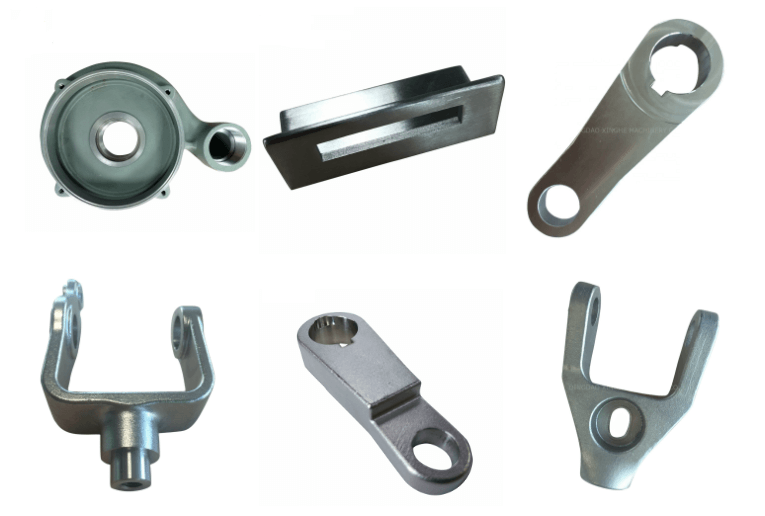Exploring the Differences Between Precision Cast Parts and Precision Forged Parts
Introduction:
Precision cast parts and precision forged parts are two distinct manufacturing processes used to produce high-quality components with precise specifications. Both methods are known for their ability to create complex shapes and maintain tight tolerances. However, there are significant differences between the two processes in terms of the materials used, the manufacturing techniques employed, and the resulting properties of the parts. This article aims to delve into these disparities and provide a comprehensive understanding of the dissimilarities between precision cast parts and precision forged parts.
Section 1: Precision Cast Parts:
1.1 Manufacturing Process: Precision casting, also known as investment casting or lost-wax casting, involves several steps. It begins with the creation of a wax pattern, which is produced either through injection molding or 3D printing. The wax pattern is then coated with a ceramic shell, which is dried and hardened. Once the shell is prepared, the wax is melted out, leaving behind a hollow cavity. Molten metal is poured into the cavity, and after solidification, the ceramic shell is removed, revealing the finished part.
1.2 Materials: Precision cast parts can be manufactured from a wide range of materials, including various metals and alloys. Common materials used in precision casting include stainless steel, carbon steel, aluminum, copper alloys, and nickel-based alloys. This versatility allows for the production of complex-shaped parts with excellent surface finishes.
1.3 Advantages and Limitations: Precision cast parts offer several advantages. Firstly, the process allows for intricate shapes and thin-walled sections that are challenging to achieve through other manufacturing methods. Secondly, it provides excellent surface finishes and dimensional accuracy. Additionally, precision casting is cost-effective for small to medium production runs.
However, precision casting has some limitations. The process may result in some porosity or inclusions within the cast parts, which can impact their mechanical properties. Furthermore, the production cycle time is longer compared to other manufacturing processes, making it less suitable for high-volume production.

Section 2: Precision Forged Parts:
2.1 Manufacturing Process: Precision forging, also known as closed-die forging or impression-die forging, involves shaping metal by applying compressive forces. The process begins with a heated billet of metal, which is placed between two dies. The dies are designed with the desired shape of the final part. The billet is then subjected to high-pressure forging, which deforms it to match the shape of the dies. The resulting part undergoes finishing operations such as trimming or machining to achieve the final dimensions and surface quality.
2.2 Materials: Precision forged parts are commonly made from metals such as steel, stainless steel, aluminum, titanium, and their alloys. The choice of material depends on the specific application requirements, including strength, corrosion resistance, and temperature resistance.
2.3 Advantages and Limitations: Precision forging offers several advantages. Firstly, it produces parts with exceptional mechanical properties, including high strength, toughness, and fatigue resistance. The forging process refines the grain structure of the metal, resulting in improved material properties. Secondly, precision forging can achieve precise dimensional tolerances and excellent surface finishes. Additionally, the process is highly efficient for large-scale production runs.
However, precision forging also has some limitations. Complex shapes with undercuts or intricate internal features are challenging to achieve through forging. Additionally, the initial tooling costs for forging can be higher compared to other manufacturing processes. The process also requires skilled operators and specialized equipment.
Section 3: Differences Between Precision Cast Parts and Precision Forged Parts:
3.1 Manufacturing Technique: The fundamental difference between precision cast parts and precision forged parts lies in their manufacturing techniques. Precision casting involves the creation of a mold and the filling of the mold with molten metal to create the desired shape. In contrast, precision forging involves the deformation of a heated billet of metal under high-pressure to achieve the desired shape.
3.2 Material Properties: Precision cast parts and precision forged parts exhibit different material properties due to the nature of their manufacturing processes. Precision cast parts often have a fine-grained structure, which can result in lower mechanical properties compared to precision forged parts. Cast parts may contain small amounts of porosity or inclusions, which can affect their strength and integrity. On the other hand, precision forged parts have a refined grain structure, which leads to improved mechanical properties such as higher strength, toughness, and fatigue resistance.
3.3 Complexity of Shapes: Precision casting is particularly well-suited for producing complex-shaped parts with intricate details, thin sections, and internal cavities. The use of wax patterns allows for the creation of intricate and delicate features that are difficult to achieve through other processes. Precision forging, while capable of producing near-net-shape parts, is better suited for simpler shapes with fewer undercuts or internal features. Complex shapes in forging often require additional machining or secondary operations to achieve the desired geometry.
3.4 Surface Finish and Dimensional Accuracy: Precision cast parts generally offer excellent surface finishes due to the use of ceramic molds, which can produce intricate details and fine surface textures. However, some post-processing may be required to achieve the desired surface smoothness. Precision forged parts, on the other hand, may have a coarser surface finish initially, but they can be machined or polished to achieve the desired surface quality. In terms of dimensional accuracy, precision casting can achieve tighter tolerances compared to precision forging, thanks to the high precision of wax patterns and ceramic molds.
3.5 Production Volume and Cost: Precision casting is often favored for small to medium production runs due to its ability to create intricate shapes and its cost-effectiveness for lower quantities. The initial tooling costs for precision casting are relatively lower compared to precision forging, making it a viable option for smaller-scale production. Precision forging, on the other hand, is more suitable for large-scale production runs due to its efficiency, shorter cycle times, and higher material utilization. However, the initial tooling costs for forging can be higher, which may make it more cost-effective for high-volume production.
3.6 Design Flexibility: Precision casting provides greater design flexibility, allowing for the creation of intricate and complex shapes. The use of wax patterns enables designers to explore intricate details and features that may not be achievable through other manufacturing processes. Precision forging, while limited in terms of complex shapes, offers flexibility in terms of material selection, allowing designers to choose from a wide range of metals and alloys to meet specific performance requirements.
Conclusion:
In summary, precision cast parts and precision forged parts are two distinct manufacturing processes with different techniques, material properties, and capabilities. Precision casting excels in creating complex-shaped parts with intricate details and is cost-effective for small to medium production runs. Precision forging, on the other hand, produces parts with superior mechanical properties, such as high strength and toughness, and is more efficient for large-scale production. Understanding the differences between precision cast parts and precision forged parts is crucial for selecting the appropriate manufacturing method based on the specific requirements of the component and the desired properties of the final product.
